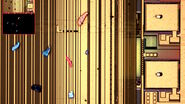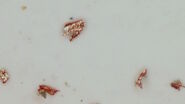Reasons why there is growing need
Steel quality is essential for reliable and high-quality products. Process control at all stages of steel production (from heat formation to the final product) ensures quality, especially as product specifications required by end-product manufacturers and end users are becoming tighter and stricter. The steel quality rating can be done efficiently by image analysis, which enable sorting, quantification and classification of non-metallic inclusions (NMIs), using international and regional standards (ASTM, DIN, JIS, ISO). Also, NMI rating done following user-defined standards, in accordance with organizational norms and processes, is becoming more and more important.

Non-metallic inclusions (NMIs) or a change in composition can impact strength, machinability, and other mechanical properties of steel [3-6]. Moreover, it is important to notice that not all NMIs will have the same effect. Manufacturers must find the right balance between steel performance and machinability and fulfill end users’ specifications and demands, so accurate examination and classification of NMIs is essential. Experience shows that it is not enough for the steel manufacturer alone to do the NMI analysis to determine steel quality. Therefore, component suppliers and end-product manufacturers must also perform NMI ratings to certify quality.
Steel quality and cleanliness depend significantly on the size, morphology, type, and quantity of NMIs and it can vary a lot even within the same production batch [7-9]. Careful monitoring of the steel quality at every step in the value chain is important due to possible variation. Therefore, there it is crucial to validate the steel quality at specific points during production and manufacturing.

The increasing need for high quality steel often results in the end-product manufacturer having more and more steel suppliers. As a result, the manufacturer must place greater emphasis on quality control for incoming materials to minimize the risk of steel quality variation [10]. Quality control is the responsibility of all parties involved, i.e., suppliers and manufacturers, and requires a clear understanding of the defined specifications and standards to be applied [10]. A low-quality steel supplier, due to lack of experience and fewer dedicated metallurgists with hands-on training, entails greater risks for component suppliers and end-product manufacturers. A well-designed workflow needs to be in place for the rating of non-metallic inclusions in order to identify low-quality, non-compliant materials and components.
The assurance and regulation of production processes to demonstrate clear compliance with up-to-date steel quality standards and specifications is more and more emphasized over the last few years. Thus, providing evidence via documentation that certifies the quality of steel from suppliers and manufacturers is becoming more and more important [10]. The documentation needs to be generated in an efficient and reliable way and make it straightforward to compare analysis results obtained from various international, regional, and organizational standards.
Solution for the growing need
Because of the large number of standards available (ISO/ASTM/DIN/EN) [11], it has become necessary to use software which enables sorting and classification of inclusions, flexible switching between standards, and an easy comparison of results from different standards. The Steel Quality Solution Suite from Leica Microsystems, utilizing the LAS X Steel Expert software, offers a flexible, reliable, and accurate way for both manual and automated rating of NMIs in steel [11]. The solution also allows users to work with multiple steel standards and adapt quickly to changes in standards.

Additionally, steel and component suppliers and end-product manufacturers are more and more interested to use a consistent test method which is compliant with standards in order to receive the ISO 17025 accreditation for NMI ratings. A NMI-rating solution, like the Steel Quality Solution Suite, can help users working towards this goal.
References
- World Steel in Figures 2019 (WorldSteel Association, Brussels, Belgium, 2019).
- Recycling, American Iron and Steel Institute.
- N. Ånmark, A. Karasev, P. Göran Jönsson, The Effect of Different Non-Metallic Inclusions on the Machinability of Steels, Materials (2015) vol. 8, iss. 2, pp. 751-783, DOI: 10.3390/ma8020751.
- H. Thoors, H. Chandrasekaran, P. Ölund, Study of some active wear mechanisms in a titanium-based cermet when machining steels, Wear (1993) vol. 162–164, part A, pp. 1–11, DOI: 10.1016/0043-1648(93)90478-5.
- J. Monnot, B. Heritier, J.Y. Cogne, Effect of Steel Manufacturing Process on the Quality of Bearing Steels, STP 987, J. Hoo, Ed. (ASTM, Philadelphia, USA, 1988) pp. 149–164, DOI: 10.1520/STP987-EB.
- S.H. Jeon, S.T. Kim, I.S. Lee, Y.S. Park, Effects of sulfur addition on pitting corrosion and machinability behaviour of super duplex stainless steel containing rare earth metals: Part 2, Corros. Sci. (2010) vol. 52, pp. 3537–3547, DOI: 10.1016/j.corsci.2010.07.002.
- H. Todoroki, K. Mizuno, Variation of Inclusion Composition in 304 Stainless Steel Deoxidized with Aluminum, Iron & Steelmaker ISS Transactions (2003) vol. 30, iss. 3, pp. 60-67.
- L. Zhang, B.G. Thomas, X. Wang, K. Cai, Evaluation and Control of Steel Cleanliness Review, 85th Steelmaking Conference Proceedings (ISS-AIME, Warrendale, PA, USA, 2002) pp. 431-452.
- A. Bytyqi, N. Puksic, M. Jenko, M. Godec, Characterization of the Inclusions in Spring Steel using Light Microscopy and Scanning Electron Microscopy, Materiali in Tehnologije (2011) vol. 45, iss. 1, pp. 55-59.
- Quality Control/Quality Assurance, Ch. 9, Interim Guidelines: Evaluation, Repair, Modification and Design of Steel Moment Frames, Report No. SAC-95-02 (SAC Steel Project, FEMA 267, 1995).
- D. Diez, J. DeRose, T. Locherer, Rate the Quality of Your Steel: Overview of standard analysis methods and practical solutions for evaluating steel inclusions, Science Lab.





